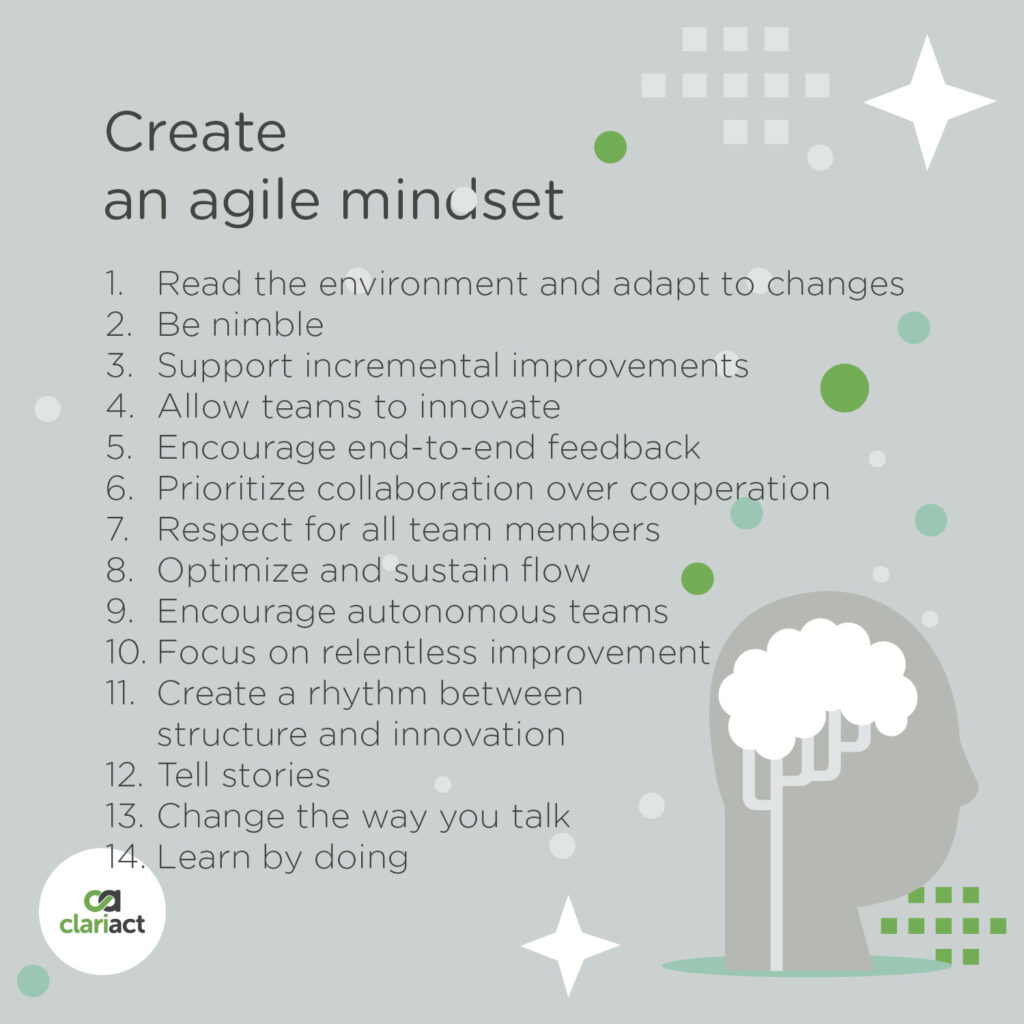Intro
Business as usual isn’t good enough in the digital age. A slight change in the existing ecosystem has massive repercussions for the people, processes and technologies involved. An agile mindset is essential for any organization to flourish. Adopting a frame of mind centered around change means adopting an agile mindset. The main question however is how do we develop this mindset? An agile mindset says customers win or businesses lose.
Welcoming change
There are no fixed rules to creating an agile mindset in a team but there are pointers that make the process smoother:
- Read the environment and adapt to changes
- Be nimble
- Support incremental improvements
- Allow teams to innovate
- Encourage end-to-end feedback
- Prioritize collaboration over cooperation
- Respect for all team members
- Optimize and sustain flow
- Encourage autonomous teams
- Focus on relentless improvement
- Create a rhythm between structure and innovation
- Tell stories
- Change the way you talk
- Learn by doing
- Read the environment and adapt to changes
An agile mindset is key when responding to change. Leaders with an agile mindset welcome change with agility and flexibility. These leaders exhibit curiosity and discard the old notions of how to shape a product or service. Leaders with an agile mindset reflect on and analyze the work done.
Be nimble
An agile mindset refers to a collection of attitudes that focuses on being nimble, innovative and creative. Leaders with an agile mindset envision new ways to solve problems, render services and consistently deliver functional products to customers. This is in contrast to a mindset that strictly follows rigid principles and seeks to meet fixed requirements.

Support incremental improvements
When implementing change, ensure that the change delivers value to customers. Any increment in a product’s state of being must add value. These increments will, over time, create a whole new idea, product or service with more real value for the customer. Therefore it’s wise to approach improvements in product delivery incrementally, as these increments add up to add value for the customers.
Allow teams to innovate
Encourage teams to introduce fresh methods, ideas or products and implement these ideas to improve their offering. Earlier, teams were often required to follow rigid plans and were only allowed to make changes after the final product is done. Teams with an agile mindset work in smaller increments and consistently make changes throughout the process based on formal requests and feedback.
Encourage end-to-end feedback
An agile mindset needs a robust feedback mechanism. This opens a team up to suggestions and ideas about product development and improvements. Oftentimes receiving feedback and being responsive to it without becoming defensive is a challenge. However, constructive feedback creates a useful feedback mechanism and helps to coach team members in the skill of giving and receiving feedback.
Prioritize collaboration over cooperation
Cooperation often implies working in isolation. Agile teams cannot be isolated and work collaboratively instead. Collaboration allows for input from other teams and customers and a willingness to communicate with one another and across multiple departments. Leaders with an agile mindset seek out opportunities for working with many members of the organization. This helps them learn from the skills and experience that other people possess.
Respect for all team members
Agile leaders foster a culture of respect and psychological safety. Team members know they won’t be punished or humiliated for speaking up with ideas, questions, concerns or mistakes. This is one of the most effective ways for teams to achieve an agile mindset. It is critical that everyone feels safe enough to take risks and be vulnerable while seeking to meet the customer’s evolving needs. This type of culture empowers everyone and team members feel valued and included as part of the process.
Optimize and sustain flow
Leaders with an agile mindset seek incremental delivery, reduced batch sizes and continuous improvement. It’s a lot easier to fix an issue as and when it occurs, rather than at the end of the project. An agile mindset helps teams avoid start-stop-start delays. It catches defects before the product is rolled out. Agile teams aim for reliable and consistent releases and fast feedback allows teams to make adjustments early and avoid big delays.
Encourage team autonomy
Innovation is the driving force of a team with an agile mindset. Allow your team to provide collaborative and constructive feedback, suggest new ideas and try different approaches. This opens the door to experimentation that could nurture your innovation culture. An agile approach allows a great deal of autonomy for the team members during projects. Innovation thrives when teams are given the freedom to find improved and more efficient solutions to their tasks instead of simply being told what to do. Provide enough time and space to nurture your team’s creativity and ability to think freely.
Focus on relentless improvement
The agile mindset is dynamic – something that is cultivated continuously as opposed to something that is achieved once-off. Teams with an agile mindset strive to find ways to optimize and improve the process as well as reflect and solve potential problems. Teams can optimize their workflow and encourage innovation through scheduled periods of reflection. These thinking-to-improve-future-processes sessions are sometimes called retrospectives.
Create a rhythm between structure and innovation
Teams with an agile mindset meet regularly to check in with each other and make adjustments as needed. This ensures that all members remain on the same page. In this way the team’s feedback is incorporated into the ongoing improvements. This brings the agile mindset full circle and supporting actions that improve results. In this way teams develop a rhythm between structure and innovation which in turn supports relentless improvement through determining the root cause of a problem.
Tell stories
Denning says “storytelling is a principal way in which you can change people’s minds and acquire an agile mindset.” Telling stories opens up our imagination to a new world. It breaks through resistance in ways that arguments often can’t. It enables us to look at the world in a new way and lay the foundation for a fresh mindset.
Change the way you talk
The way we talk changes mindsets: stop saying “I can’t” and start saying “I can’t yet” and it will change your whole world. Language is a powerful tool because talking shapes our thinking. The words we use form our visions. The way we speak transforms our mind. In contrast, outdated and traditional language and mental images keeps an outdated and traditional mindset in place.
Learn by doing
We learn by doing things. We obtain a mindset through practice, in incremental, bite-sized chunks.. It therefore follows that changing your mindset takes time because knowing in your mind what you’re required to do is not the same as an integrated knowing with your whole self.
Agility is a journey
Cultivating an agile mindset is a journey. It is a journey full of surprises. The beauty of an agile mindset is our ability to become responsive to changes. This mindset enables us to seize opportunities, learn from other people, be curious and become free from the old ideas of how our products and services should be created. It allows us to read the environment and adapt to changes. It creates a space that promotes growth and lets us track (and celebrate) our improvements over time.

